Related Research Articles
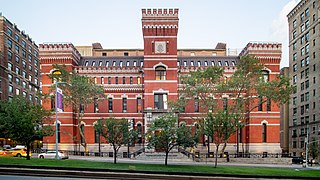
The Seventh Regiment Armory, also known as Park Avenue Armory, is a historic National Guard armory building located at 643 Park Avenue in the Upper East Side neighborhood of Manhattan, New York City. The building is a brick and stone structure built in 1880 and designed in the Gothic Revival style by Charles Clinton.

The Clinton House is an 18th-century Georgian stone building in the city of Poughkeepsie, Dutchess County, New York, United States. It is a New York State Historic Site and has been listed in the National Register of Historic Places as a historic place of local significance since 1982. The house was named for George Clinton, who served as the first Governor of New York and fourth Vice-President of the United States. He was believed to have lived there after the American Revolutionary War, but it is now known that it was never his residence.

Charles Evans Hughes House is a historic house at 2223 R Street, NW in the Sheridan-Kalorama neighborhood of Washington, D.C.. Built in 1907, it was from 1930 to 1948 the home of Charles Evans Hughes (1862–1948), a prominent Republican politician and from 1930–1941 the Chief Justice of the United States. It was declared a National Historic Landmark in 1972 and is a contributing property to the Sheridan-Kalorama Historic District. It presently serves as the official residence of the Ambassador of Myanmar to the United States.

The Southwest Virginia Museum Historical State Park is a Virginia museum, run as a state park, dedicated to preserving the history of the southwestern part of the state. It is located in Big Stone Gap, in a house built in the 1880s for Virginia Attorney General Rufus A. Ayers. It was designed and built by Charles A. Johnson. Construction began in 1888 and was completed in 1895.
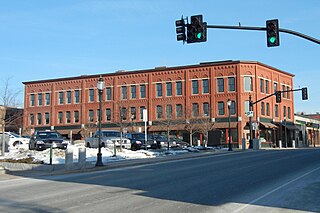
The Masonic Block is an historic commercial block in Reading, Massachusetts. This three story brick building is distinctive in the town for its Renaissance Revival styling. It was built in 1894 by the local Reading Masonic Temple Corporation, and housed the local Masonic lodge on the third floor. The building was listed on the National Register of Historic Places in 1984.

The Clinton Avenue Historic District in Albany, New York, United States, is a 70-acre (28 ha) area along that street between North Pearl and Quail streets. It also includes some blocks along neighboring streets such as Lark and Lexington.

The buildings at 744–750 Broadway in Albany, New York, United States, sometimes known as Broadway Row, are four brick row houses on the northwest corner of the intersection with Wilson Street. They were built over a period of 40 years in the 19th century, using a variety of architectural styles reflecting the times they were built in. At that time the neighborhood, known as the Fifth Ward, was undergoing rapid expansion due to the Erie Canal and the city's subsequent industrialization.

There are 69 properties listed on the National Register of Historic Places in Albany, New York, United States. Six are additionally designated as National Historic Landmarks (NHLs), the most of any city in the state after New York City. Another 14 are historic districts, for which 20 of the listings are also contributing properties. Two properties, both buildings, that had been listed in the past but have since been demolished have been delisted; one building that is also no longer extant remains listed.

The Phillip Worley House is a historic building located in downtown Davenport, Iowa, United States. It was individually listed on the National Register of Historic Places since 1983. In 2020 it was included as a contributing property in the Davenport Downtown Commercial Historic District.
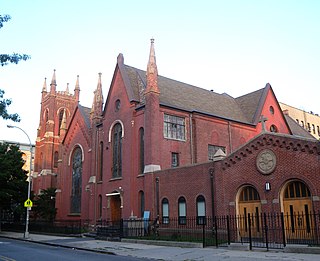
Clinton Hill Historic District is a national historic district in Clinton Hill, Brooklyn, in New York City. It consists of 1,063 largely residential contributing buildings built between the 1840s and 1930 in popular contemporary and revival styles. Buildings include freestanding mansions, row houses, and apartment buildings. The district includes the mansions of Clinton Avenue, built in the 1870s and 1880s. The most prominent of these are linked to Charles Pratt, who built a mansion for himself at 232 Clinton Avenue in 1874, the year his Charles Pratt & Company was acquired by Standard Oil, and one each as wedding presents for three of his four sons. These four mansions can be seen on Clinton Avenue between DeKalb and Willoughby. The rest of the historic district is noted for its prominent Italianate and Beaux-Arts rowhouses. The Clinton Hill South Historic District was listed in 1986.
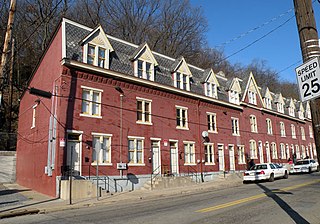
The houses at 2501–2531 Charles Street in the Perry South neighborhood of Pittsburgh, Pennsylvania, USA, were built in 1885. The row originally included 25 nearly identical houses, 13 feet wide and 35 feet deep. All but 2 of the buildings survive. They each have two rooms on the first floor, a parlor and a kitchen, and two bedrooms on the second floor. A third bedroom comprises the third floor behind the mansard roof. The houses rise gradually with the street, stepping up about 2 feet every fifth house. Every fifth house also has a large decorative gable over the mansard roof.

The Cal Shaw Adobe Duplex is an adobe house located at 129 Central Street in Tonopah, Nevada. The house, which was built in 1905, is typical of the adobe homes commonly built in Tonopah in the early 1900s. The building's exterior is scored to resemble stone; the home's design also features a decorative frieze and a porch supported by turned columns. The home has changed little since its construction and has been called "the best preserved adobe residence in Tonopah" by a local historic survey.

The Stone Jail Building and Row House are two adjacent stone buildings located on Water Street in Tonopah, Nevada. The jail was built in 1903 and the adjacent row house in 1908. Both building were at one time used as a brothel. The buildings were added to the National Register of Historic Places in 1982.
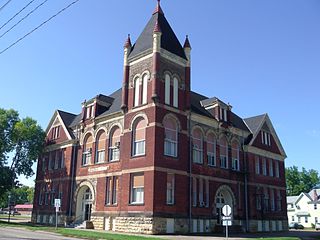
Clinton High School and Public Library, also known as Roosevelt School, is an historic structure located in Clinton, Iowa, United States. It was listed on the National Register of Historic Places in 2012.

The Luke Bone Grocery-Boarding House is a historic mixed-use commercial and residential building at Main and Market Streets in Bald Knob, Arkansas. It is a two-story structure, faced in cut stone but structurally built out of brick. It has a single storefront, sheltered by an open porch, with a pair of sash windows above. When built c. 1915, it housed a shop and restaurant below, and a hotel above, serving railroad passengers. The hotel was later converted to a boarding house, and the cut stone exterior was added in the 1930s, when the style was popularized by projects of the Works Progress Administration.

The George Johnson House is an historic building located near Calamus, Iowa, United States. It was listed on the National Register of Historic Places in 2000.
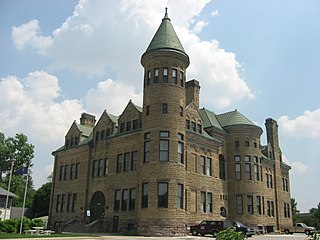
Old Frankfort Stone High School, also known as Old Stoney, is a historic high school building in Frankfort, Clinton County, Indiana. It was built in 1892, and is a 2 1/2-story, Richardsonian Romanesque style sandstone building on a raised basement. It has Indiana limestone trim, a large round arched entrance, four large stone chimneys, and four-story corner tower with a tall conical roof. The building was damaged by fire in 1922, and rebuilt with the work completed in 1926. The building housed a junior high school from 1962 to 1974, after which it ceased use as a public school.

Fort Apache Historic Park is a tribal historic park of the White Mountain Apache, located at the former site of Fort Apache in the Fort Apache Indian Reservation. The park interprets the rich and troubled history of relations between the Apache and other Native American tribes at the fort, which was converted into a Bureau of Indian Affairs boarding school after its military use ended. The park, which covers 288 acres (117 ha) of the former fort and school, as well as a nearby military cemetery, form the National Historic Landmark Fort Apache and Theodore Roosevelt School historic district.

Stone Row is a historic building located at St. Charles, St. Charles County, Missouri. It consists of two 2 1/2-story stone buildings built about 1815 that were once separated by a 20-foot space. About 1860, the space was filled by a 2 1/2-story brick structure. Stone Row dates to the earliest settlement of St. Charles. They were built for commercial and residential purposes.

Dunham's Mill, also known as Parry's Mill, is a historic building located at 7 Lower Center Street in Clinton, Hunterdon County, New Jersey. The gristmill was in operation from 1837 to 1952. It was added to the National Register of Historic Places on April 15, 1982 for its significance in commerce and industry. It shares the Clinton Dam across the South Branch Raritan River with the David McKinney Mill on the other side of the river. Since 1952, it has been home to the Hunterdon Art Museum, described by an art critic as the "most charming and picturesque" museum in the state.
References
- 1 2 "National Register Information System". National Register of Historic Places . National Park Service. July 9, 2010.
- ↑ Janus Associates (September 1980). "Nye County Historic Property Survey: Charles Clinton Stone Row House" . Retrieved July 16, 2013.